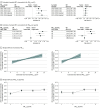Association Between Ambient Air Pollution and Amyloid Positron Emission Tomography Positivity in Older Adults With Cognitive Impairment
- PMID: 33252608
- PMCID: PMC7879238
- DOI: 10.1001/jamaneurol.2020.3962
Association Between Ambient Air Pollution and Amyloid Positron Emission Tomography Positivity in Older Adults With Cognitive Impairment
Abstract
Importance: Amyloid-β (Aβ) deposition is a feature of Alzheimer disease (AD) and may be promoted by exogenous factors, such as ambient air quality.
Objective: To examine the association between the likelihood of amyloid positron emission tomography (PET) scan positivity and ambient air quality in individuals with cognitive impairment.
Design, setting, and participants: This cross-sectional study used data from the Imaging Dementia-Evidence for Amyloid Scanning Study, which included more than 18 000 US participants with cognitive impairment who received an amyloid PET scan with 1 of 3 Aβ tracers (fluorine 18 [18F]-labeled florbetapir, 18F-labeled florbetaben, or 18F-labeled flutemetamol) between February 16, 2016, and January 10, 2018. A sample of older adults with mild cognitive impairment (MCI) or dementia was selected.
Exposures: Air pollution was estimated at the patient residence using predicted fine particulate matter (PM2.5) and ground-level ozone (O3) concentrations from the Environmental Protection Agency Downscaler model. Air quality was estimated at 2002 to 2003 (early, or approximately 14 [range, 13-15] years before amyloid PET scan) and 2015 to 2016 (late, or approximately 1 [range, 0-2] years before amyloid PET scan).
Main outcomes and measures: Primary outcome measure was the association between air pollution and the likelihood of amyloid PET scan positivity, which was measured as odds ratios (ORs) and marginal effects, adjusting for demographic, lifestyle, and socioeconomic factors and medical comorbidities, including respiratory, cardiovascular, cerebrovascular, psychiatric, and neurological conditions.
Results: The data set included 18 178 patients, of which 10 991 (60.5%) had MCI and 7187 (39.5%) had dementia (mean [SD] age, 75.8 [6.3] years; 9333 women [51.3%]). Living in areas with higher estimated biennial PM2.5 concentrations in 2002 to 2003 was associated with a higher likelihood of amyloid PET scan positivity (adjusted OR, 1.10; 95% CI, 1.05-1.15; z score = 3.93; false discovery rate [FDR]-corrected P < .001; per 4-μg/m3 increments). Results were similar for 2015 to 2016 data (OR, 1.15; 95% CI, 1.05-1.26, z score = 3.14; FDR-corrected P = .003). An average marginal effect (AME) of +0.5% (SE = 0.1%; z score, 3.93; 95% CI, 0.3%-0.7%; FDR-corrected P < .001) probability of amyloid PET scan positivity for each 1-μg/m3 increase in PM2.5 was observed for 2002 to 2003, whereas an AME of +0.8% (SE = 0.2%; z score = 3.15; 95% CI, 0.3%-1.2%; FDR-corrected P = .002) probability was observed for 2015 to 2016. Post hoc analyses showed no effect modification by sex (2002-2003: interaction term β = 1.01 [95% CI, 0.99-1.04; z score = 1.13; FDR-corrected P = .56]; 2015-2016: β = 1.02 [95% CI, 0.98-1.07; z score = 0.91; FDR-corrected P = .56]) or clinical stage (2002-2003: interaction term β = 1.01 [95% CI, 0.99-1.03; z score = 0.77; FDR-corrected P = .58]; 2015-2016: β = 1.03; 95% CI, 0.99-1.08; z score = 1.46; FDR-corrected P = .47]). Exposure to higher O3 concentrations was not associated with amyloid PET scan positivity in both time windows.
Conclusions and relevance: This study found that higher PM2.5 concentrations appeared to be associated with brain Aβ plaques. These findings suggest the need to consider airborne toxic pollutants associated with Aβ pathology in public health policy decisions and to inform individual lifetime risk of developing AD and dementia.
Conflict of interest statement
Figures



Comment in
-
Air pollution linked to neurodegeneration markers.Nat Med. 2021 Jan;27(1):21. doi: 10.1038/s41591-020-01221-5. Nat Med. 2021. PMID: 33442009 No abstract available.
References
Publication types
MeSH terms
Substances
Grants and funding
LinkOut - more resources
Full Text Sources
Other Literature Sources
Medical

